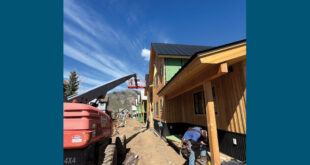Maroon Bells-Snowmass Wilderness in cross-hairs of USFS preservation efforts
by Toni Todd
In response to widespread ecological damage caused by too many campers, the United States Forest Service (USFS) has rolled out its draft Overnight Visitor Use Management Plan for the Maroon Bells-Snowmass Wilderness (MBSW).
The plan includes a proposal to require permits for camping at Conundrum Hot Springs and Conundrum Creek, a destination many people embark on from the West Maroon trailhead north of Gothic. The new permitting and online reservation system the USFS hopes to implement may also impose a $10 per person, per night fee. The plan is expected to go into effect the summer of 2018.
“The decision is based on years of monitoring data, public input, extensive inventories, and environmental analysis findings that demonstrated the need for action to protect the natural resources from increasing degradation resulting from overnight use,” said Karen Schroyer, Aspen-Sopris district ranger.
To provide a quick, clear idea of what’s happening at Conundrum, USFS officials have posted a short, telling video to the White River National Forest (WRNF) website: “Wilderness in Peril—The Maroon Bells-Snowmass Wilderness.” Footage shows Hot Springs soakers shoulder-to-shoulder, crowded into the steaming pool, and the aftermath all around from what a crowd like that leaves behind.
According to the USFS, the White River National Forest is the most visited forest in the nation, and Conundrum Hot Springs has become a popular summer destination within that forest. The agency reports a 40 percent increase in visitors to the area since 2012. That popularity, combined with what the Forest Service describes as an increasing disregard for the pack-it-in, pack-it-out mantra, has marred an iconic Colorado destination.
The MBSW Overnight Visitor Use Management Plan, cites trash, human and pet waste, rogue fire rings, campsites too close to waterways and trails, hard-packed soil where camping occurs, bear encounters due to improper food storage, live trees chopped down for firewood, trampled plants—too many people, and most important, too many who disregard low-impact practices, causing serious ecological damage and ruining the overall wilderness experience.
According to the plan, “peak crowds from July through September overwhelm the number of available camping sites, leading to the creation of new sites. This spreading impact from increasing and concentrated overnight use is the primary issue related to visitor use management in the MBSW.”
Schroyer said the MBSW will be divided into zones, with each zone designated a maximum number of GAOTs (groups at one time) it can sustain. The Conundrum Hot Springs zone, for example, has 22 compliant campsites and can support 20 GAOTs. The number of GAOTs will be monitored by zone. The average group size is 2.8 people per campsite.
An inventory taken by the USFS of campsites in the MBSW found 729 spots, with only 373 of those, or 51 percent, complying with the WRNF’s own campsite guidelines.
Too many campers building too many fire rings is also cause for concern. “Long-term heavy visitation,” says the plan, “and campfire use along popular routes and at destinations, has exhausted all available firewood. Persistent campfire use despite regulatory prohibition requires the use of standing green trees as a firewood source. Significant tree damage and forest structure impacts have accumulated as a result of this behavior. The sterilization of soil and scarring of rocks associated with illegal campfire use is also causing negative effects to natural conditions. From 2011 to 2015, rangers removed and naturalized 964 illegal campfire rings in the MBSW.”
The release of the draft plan on June 29 initiated a 45-day objection period. Only people who submitted comments during the initial scoping process for the plan are eligible to object.
“I don’t think we got one comment that was against a permitting plan,” Schroyer recently told the Aspen Times.
Objections will be compiled, reviewed and incorporated into a Draft Environmental Assessment. A second 45-day objection period will follow that draft, after which the final Environmental Assessment will be completed.
According to the current Draft MBSW Overnight Visitor Use Plan, the final plan “will consist of a document describing elements of the selected alternative that will describe final zones, indicators, thresholds and management actions to be used for overnight use management.”
Concern for the degradation at Conundrum has spread beyond the local USFS offices. The Leave No Trace (LNT) Center for Outdoor Ethics has designated the Conundrum Hot Springs area as a “Hot Spot.” Hot Spots are areas of public land throughout the U.S. deemed by LNT to be in trouble due to overuse. Leave No Trace is a national organization based in Boulder that helps restore damaged areas by teaching and inspiring people to enjoy them responsibly.
“While the announcement of this draft decision is an exciting milestone for addressing impacts in the Maroon Bells-Snowmass Wilderness,” says Schroyer, “we will be looking for ways in the future to ensure we have the resources to implement the plan long-term.”
Phase 2 of the plan will expand the overnight management area to include the Four Pass Loop, which includes Crater Lake, Maroon Lake, Snowmass Lake, North Fork, East Fork and Upper Snowmass.
Implementation of the Four Pass Loop Reservation System will occur sometime after the Conundrum Hot Springs and Conundrum Creek system is up and running. The Four Pass Loop is a 28-mile backpacking route that has seen similar damage to that of Conundrum, to include vegetation damage and soil erosion.
During the summer of 2016, rangers reported finding 273 piles of unburied human waste in the Maroon Bells-Snowmass Wilderness.
The entire plan can be found by googling: White River National Forest Overnight Visitors Use Management Program.
 The Crested Butte News Serving the Gunnison Valley since 1999
The Crested Butte News Serving the Gunnison Valley since 1999

